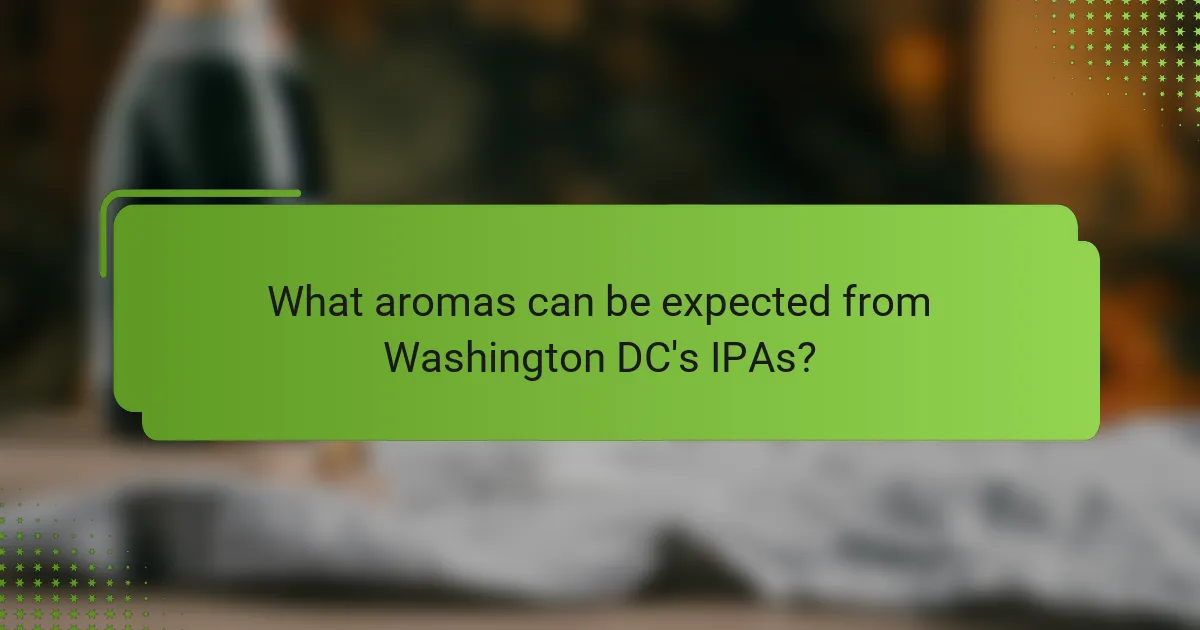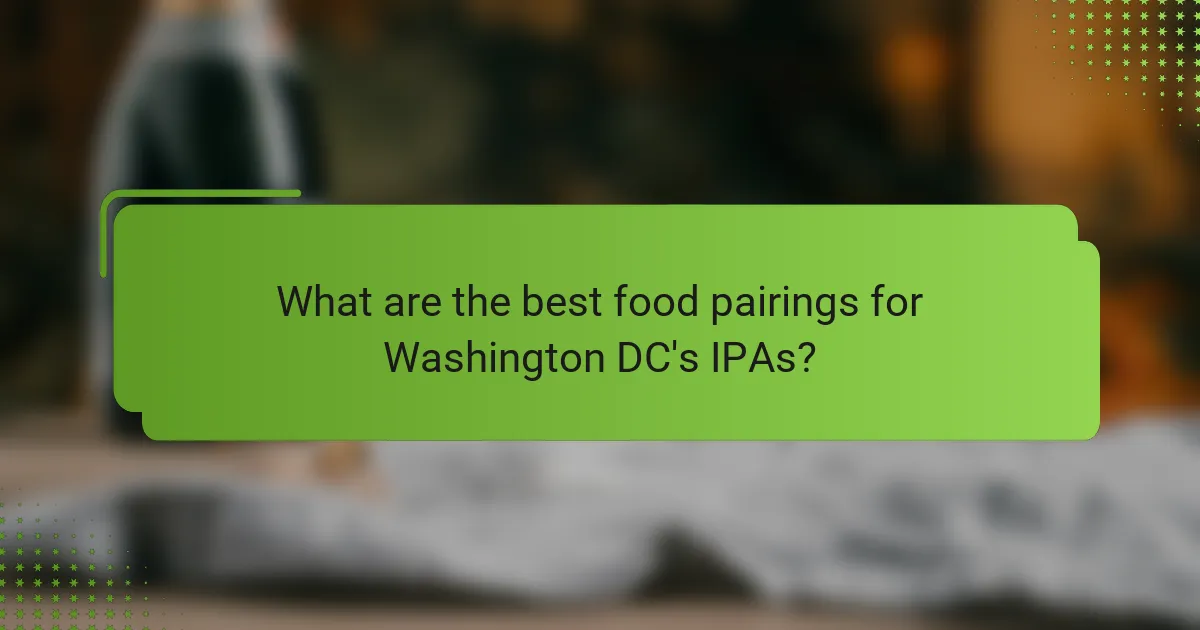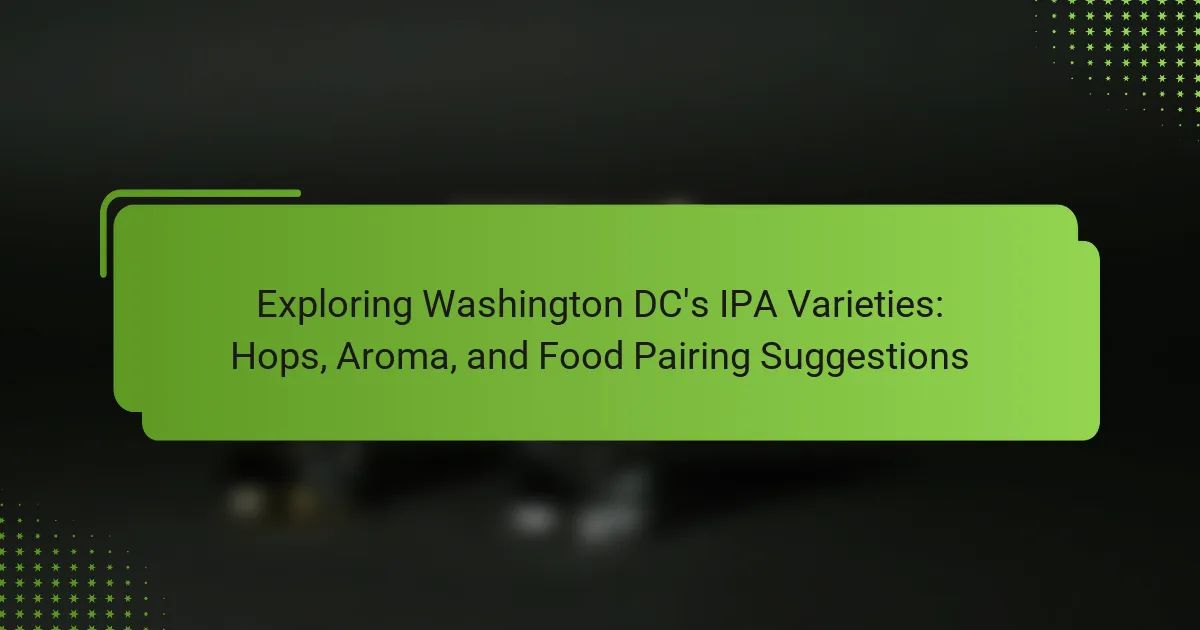Washington DC’s craft beer scene prominently features several varieties of India Pale Ales (IPAs), including West Coast IPAs, New England IPAs, and Double IPAs. Each style offers distinct characteristics: West Coast IPAs are recognized for their clarity and strong hop bitterness, while New England IPAs are hazy with juicy, fruity hop flavors. Double IPAs boast higher alcohol content and a more intense hop profile. The article explores the diverse aromas found in these IPAs, such as citrus, pine, and tropical fruit, primarily derived from popular hop varieties like Citra, Mosaic, and Simcoe. Additionally, it provides food pairing suggestions, highlighting how spicy foods, grilled meats, and rich cheeses complement the unique flavors of Washington DC’s IPAs.

What are the different varieties of IPAs found in Washington DC?
Washington DC features several varieties of IPAs, including West Coast IPAs, New England IPAs, and Double IPAs. West Coast IPAs are known for their clear appearance and strong hop bitterness. New England IPAs, in contrast, are hazy and emphasize juicy, fruity hop flavors. Double IPAs contain higher alcohol content and a more intense hop profile. These varieties reflect the diverse brewing culture in the region. Local breweries often experiment with unique hop combinations, enhancing the flavor spectrum. The popularity of these styles showcases the craft beer movement in Washington DC.
How do the characteristics of Washington DC IPAs differ from others?
Washington DC IPAs typically feature a unique blend of hops that impart distinct flavors. These beers often emphasize citrus and tropical fruit notes, setting them apart from IPAs in other regions. The local brewing scene frequently incorporates innovative hop varieties. This experimentation leads to unique aroma profiles. Additionally, DC’s IPAs may showcase a balanced malt backbone, contrasting with the more hop-forward styles found elsewhere. The brewing culture in the area is influenced by diverse culinary traditions. This results in IPAs that pair well with a variety of local foods. Overall, Washington DC IPAs are characterized by their distinct hop profiles and culinary influences.
What are the key ingredients that define Washington DC IPAs?
The key ingredients that define Washington DC IPAs include hops, malt, yeast, and water. Hops provide the signature bitterness and aroma. Common hop varieties used are Citra, Mosaic, and Simcoe. These hops contribute citrusy and tropical fruit flavors. Malt balances the bitterness with sweetness. Pale malt is typically used, along with caramel malts for added complexity. Yeast strains influence the flavor profile, often showcasing fruity esters. Water quality is crucial, affecting the overall taste. Washington DC’s water profile is suitable for brewing IPAs, enhancing their characteristics.
How does the brewing process influence the flavor of these IPAs?
The brewing process significantly influences the flavor of IPAs through several key stages. The selection of hops is crucial, as different varieties impart unique flavors and aromas. During the boiling phase, hops release essential oils, which contribute to bitterness and complexity. The fermentation process also plays a vital role. Yeast strains can affect fruity or floral notes in the final product. Additionally, the temperature at which fermentation occurs impacts flavor profiles. Higher temperatures often yield more esters, enhancing fruity flavors. Furthermore, the use of adjuncts like grains or sugars can add depth and sweetness. Lastly, the conditioning phase allows flavors to meld, resulting in a smoother taste. Each step in the brewing process is essential for creating the distinct flavors found in Washington DC’s IPAs.
What role do hops play in Washington DC’s IPA varieties?
Hops are essential in Washington DC’s IPA varieties for flavor and aroma. They contribute bitterness that balances the malt sweetness. Different hop varieties impart unique characteristics. For example, Citra hops offer citrus notes, while Mosaic hops provide tropical fruit flavors. The combination of hops defines the overall profile of the IPA. Washington DC breweries often experiment with local hop varieties. This experimentation leads to diverse and innovative IPA offerings. The use of hops also enhances the beer’s aroma, making it more appealing to consumers.
Which hop varieties are most commonly used in these IPAs?
Citra, Mosaic, and Simcoe are the most commonly used hop varieties in IPAs. Citra hops provide a strong citrus aroma and flavor. Mosaic hops are known for their complex aroma, featuring tropical and earthy notes. Simcoe hops contribute pine, citrus, and floral characteristics. These hop varieties are favored by brewers for their ability to enhance the overall flavor profile of IPAs. Their popularity is supported by numerous breweries in Washington DC that utilize them in their recipes.
How do different hops affect the aroma and bitterness of the beer?
Different hops significantly influence the aroma and bitterness of beer. Hops contain essential oils that contribute to the beer’s aroma. For instance, Citra hops impart citrus and tropical fruit notes. In contrast, Cascade hops provide floral and grapefruit aromas.
Bitterness is primarily derived from alpha acids in hops. Higher alpha acid levels result in increased bitterness. For example, Columbus hops have a high alpha acid content, leading to a more pronounced bitterness. Conversely, lower alpha acid hops, like Saaz, contribute less bitterness and more aromatic qualities.
The timing of hop addition during brewing also affects aroma and bitterness. Early additions enhance bitterness, while late additions boost aroma. This interplay between different hop varieties creates a diverse range of flavor profiles in IPAs.

What aromas can be expected from Washington DC’s IPAs?
Washington DC’s IPAs typically feature a range of aromas including citrus, pine, and tropical fruit. Citrus aromas often include notes of grapefruit and orange. Pine aromas provide a resinous quality that complements the hops. Tropical fruit scents may include mango, pineapple, and passionfruit. Additionally, some IPAs may exhibit floral and herbal notes. These aromas are primarily derived from the hops used in the brewing process. Popular hop varieties in DC IPAs include Citra, Mosaic, and Simcoe, known for their aromatic profiles. The combination of these hops creates a complex aroma experience in the final product.
How do the aromas of Washington DC IPAs compare to other regions?
The aromas of Washington DC IPAs are often characterized by a unique blend of citrus, pine, and floral notes. This distinct profile can be attributed to the specific hop varieties used by local brewers. Compared to IPAs from other regions, DC IPAs tend to emphasize a more balanced aroma with less emphasis on tropical fruit. For instance, West Coast IPAs typically showcase stronger tropical and resinous aromas. Additionally, New England IPAs often feature juicy and fruity aromas, which differ from the more nuanced profiles found in Washington DC. The local brewing scene in DC often incorporates regional ingredients, enhancing the aromatic complexity. This results in a sensory experience that reflects the area’s unique brewing culture. Studies on regional beer styles indicate that local environmental factors influence hop aroma profiles significantly.
What are the dominant aromatic profiles found in these IPAs?
The dominant aromatic profiles found in these IPAs are typically citrus, pine, and floral notes. Citrus aromas often include grapefruit, orange, and lemon. Pine notes provide a resinous quality that enhances the overall experience. Floral characteristics can range from subtle to pronounced, adding complexity. Additionally, some IPAs exhibit tropical fruit scents, such as mango and pineapple. These aromatic profiles are derived from the specific hop varieties used in brewing. Popular hops like Citra, Simcoe, and Mosaic contribute significantly to these profiles. The balance of these aromas creates a unique sensory experience for the drinker.
How can the aroma enhance the overall drinking experience?
Aroma significantly enhances the overall drinking experience by engaging the senses and influencing flavor perception. The olfactory system plays a crucial role in taste. Studies show that approximately 80% of what we perceive as taste comes from smell. A well-crafted IPA’s aroma can evoke specific hops’ characteristics, such as citrus, pine, or floral notes. This aromatic complexity prepares the palate for the flavors to come. Enhanced aroma can lead to greater enjoyment and satisfaction during consumption. Additionally, aroma contributes to the beer’s overall identity and character. Therefore, the aroma is essential in creating a memorable drinking experience.
What factors contribute to the aroma of Washington DC IPAs?
The aroma of Washington DC IPAs is primarily influenced by the types of hops used. Hops contribute essential oils that create distinct fragrances. Common hop varieties include Citra, Mosaic, and Simcoe. These hops impart citrus, pine, and floral notes to the beer. The brewing process also affects aroma. Dry hopping, which adds hops during fermentation, enhances the aromatic profile. Additionally, the malt used can provide a backdrop that complements hop aromas. Yeast strains can further influence the overall scent, adding fruity or estery characteristics. Temperature during fermentation can also impact the release of aromatic compounds.
How do the brewing techniques influence the aromatic qualities?
Brewing techniques significantly influence the aromatic qualities of beer. Different methods such as boiling, fermentation, and dry hopping impact the release of aromatic compounds. For example, the temperature and duration of boiling can alter the extraction of hop oils. Higher temperatures can enhance the volatility of these oils, leading to stronger aromas. Fermentation techniques also play a role; yeast strains can produce unique esters and phenols that contribute to the aroma. Additionally, dry hopping introduces fresh hop aromas by adding hops after fermentation, preserving their aromatic properties. Research indicates that these variations can result in distinct aromatic profiles in IPAs, enhancing their complexity and appeal.
What role do the ingredients play in creating distinct aromas?
Ingredients play a crucial role in creating distinct aromas in IPAs. The primary ingredients include hops, malt, and yeast. Hops contribute floral, citrus, and pine notes due to their essential oils. Different hop varieties produce unique aromatic profiles. Malt adds sweetness and caramel scents, balancing the bitterness from hops. Yeast also influences aroma through fermentation by producing esters and phenols. For example, certain yeast strains can impart fruity or spicy notes. Together, these ingredients interact to create a complex aroma that defines each IPA’s character. The combination of specific ingredients leads to the distinctive scent profiles that beer enthusiasts recognize.

What are the best food pairings for Washington DC’s IPAs?
Washington DC’s IPAs pair best with spicy foods, grilled meats, and rich cheeses. Spicy dishes, such as buffalo wings or spicy tacos, complement the hoppy bitterness. Grilled meats, like burgers or BBQ, enhance the malt sweetness. Rich cheeses, such as blue cheese or aged cheddar, balance the IPA’s bitterness. These pairings enhance the overall flavor experience. Many local breweries recommend these combinations for optimal taste.
How can food enhance the flavors of these IPAs?
Food can enhance the flavors of IPAs by complementing their hop characteristics. Pairing food with IPAs can elevate the tasting experience. For instance, spicy dishes can amplify the bitterness of hops. Citrusy foods can highlight the fruity notes in the beer. Rich, fatty foods can balance the IPA’s bitterness. Grilled meats can enhance the roasted malt flavors. The right cheese can create a harmonious blend with the beer’s profile. Research indicates that food and beer pairings can significantly improve flavor perception.
What types of cuisine pair well with Washington DC IPAs?
Washington DC IPAs pair well with spicy, rich, and savory cuisines. Dishes like Indian curry enhance the hoppy bitterness of the beer. The heat from spicy foods complements the IPA’s aromatic profile. Barbecue also works well, as the smoky flavors balance the beer’s citrus notes. Additionally, seafood such as grilled shrimp or fish tacos pairs nicely with the refreshing qualities of IPAs. These pairings are supported by the hoppy character and diverse flavor profiles of Washington DC’s IPAs.
How can specific dishes complement the unique attributes of these beers?
Specific dishes can enhance the unique attributes of Washington DC’s IPAs by pairing complementary flavors. IPAs often have hoppy bitterness and citrus notes. Dishes with rich, fatty proteins, like grilled salmon, balance the bitterness. Spicy foods, such as Thai curry, can amplify the citrus aroma. Salty snacks, like pretzels, accentuate the hop flavor. Additionally, cheese platters featuring sharp cheddar can create a delightful contrast. These pairings leverage the IPA’s characteristics to elevate the dining experience. Research shows that food and beer pairings enhance flavor perception (source: “The Science of Food and Beer Pairing,” Journal of Culinary Science & Technology).
What tips can enhance the pairing experience with Washington DC IPAs?
To enhance the pairing experience with Washington DC IPAs, consider the following tips. First, focus on the hop profile of the IPA. IPAs from DC often feature citrus, pine, or floral notes. Pair these flavors with complementary foods. For instance, citrusy IPAs go well with seafood and salads. Piney IPAs can enhance grilled meats and barbecue dishes.
Next, consider the bitterness level of the IPA. High bitterness can balance rich, fatty foods like burgers or creamy cheeses. Additionally, take note of the aroma. IPAs with strong aromas can elevate the tasting experience when paired with aromatic dishes.
Lastly, experiment with local cuisine. DC has a diverse food scene that can complement the unique characteristics of local IPAs. This approach not only enhances the pairing experience but also supports local businesses.
How should one approach selecting food to pair with different IPA styles?
To select food that pairs well with different IPA styles, consider the IPA’s flavor profile. IPAs often feature strong hop bitterness, fruity notes, and varying malt characteristics. For hoppy IPAs, foods with bold flavors, like spicy dishes or grilled meats, complement the bitterness. Fruity IPAs pair well with lighter fare such as salads or seafood, as they enhance the fruity notes. Malty IPAs benefit from richer foods like burgers or barbecue, as the malt can balance the bitterness. The key is to match intensity; stronger IPAs require bolder dishes. This approach enhances the overall tasting experience and highlights the unique attributes of each IPA style.
What are common mistakes to avoid when pairing food with IPAs?
Common mistakes to avoid when pairing food with IPAs include overlooking the beer’s bitterness. IPAs often have a high hop content, which can clash with certain flavors. Pairing IPAs with overly spicy dishes can amplify bitterness. Additionally, choosing rich, fatty foods may overwhelm the beer’s hoppy notes. Ignoring the beer’s aroma can lead to mismatched pairings. For example, citrusy IPAs pair well with seafood, while piney varieties suit grilled meats. Lastly, failing to consider the beer’s alcohol content may result in overpowering combinations. These mistakes can diminish the overall tasting experience.
The main entity of the article is Washington DC’s IPA varieties, which include West Coast IPAs, New England IPAs, and Double IPAs. The article provides an overview of the characteristics, key ingredients, and brewing processes that define these IPAs, highlighting the role of hops in creating distinct flavors and aromas. It also discusses the best food pairings for these beers, emphasizing how different cuisines can enhance the overall tasting experience. Additionally, the article explores common mistakes to avoid when pairing food with IPAs, ensuring a comprehensive understanding of Washington DC’s unique brewing culture.
